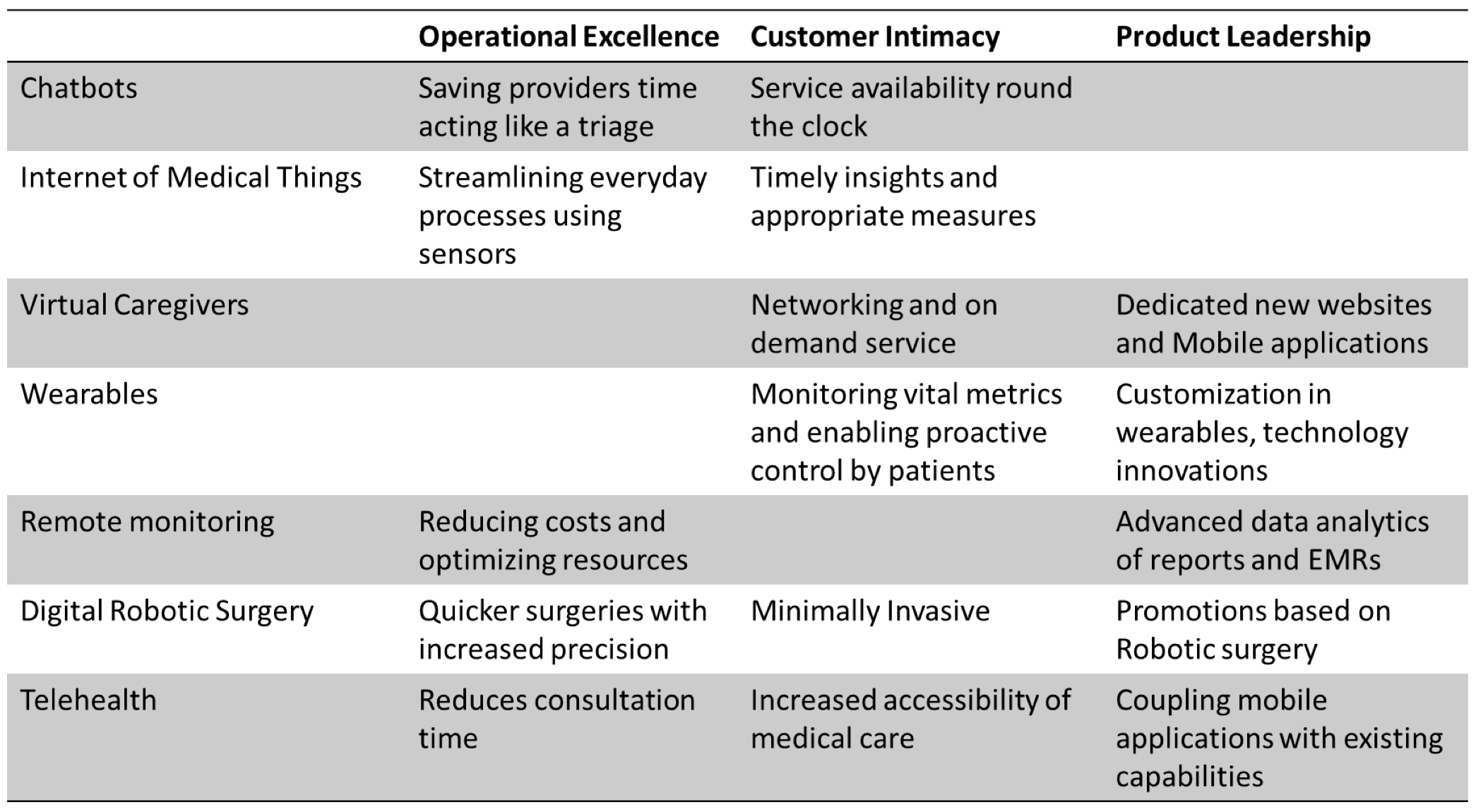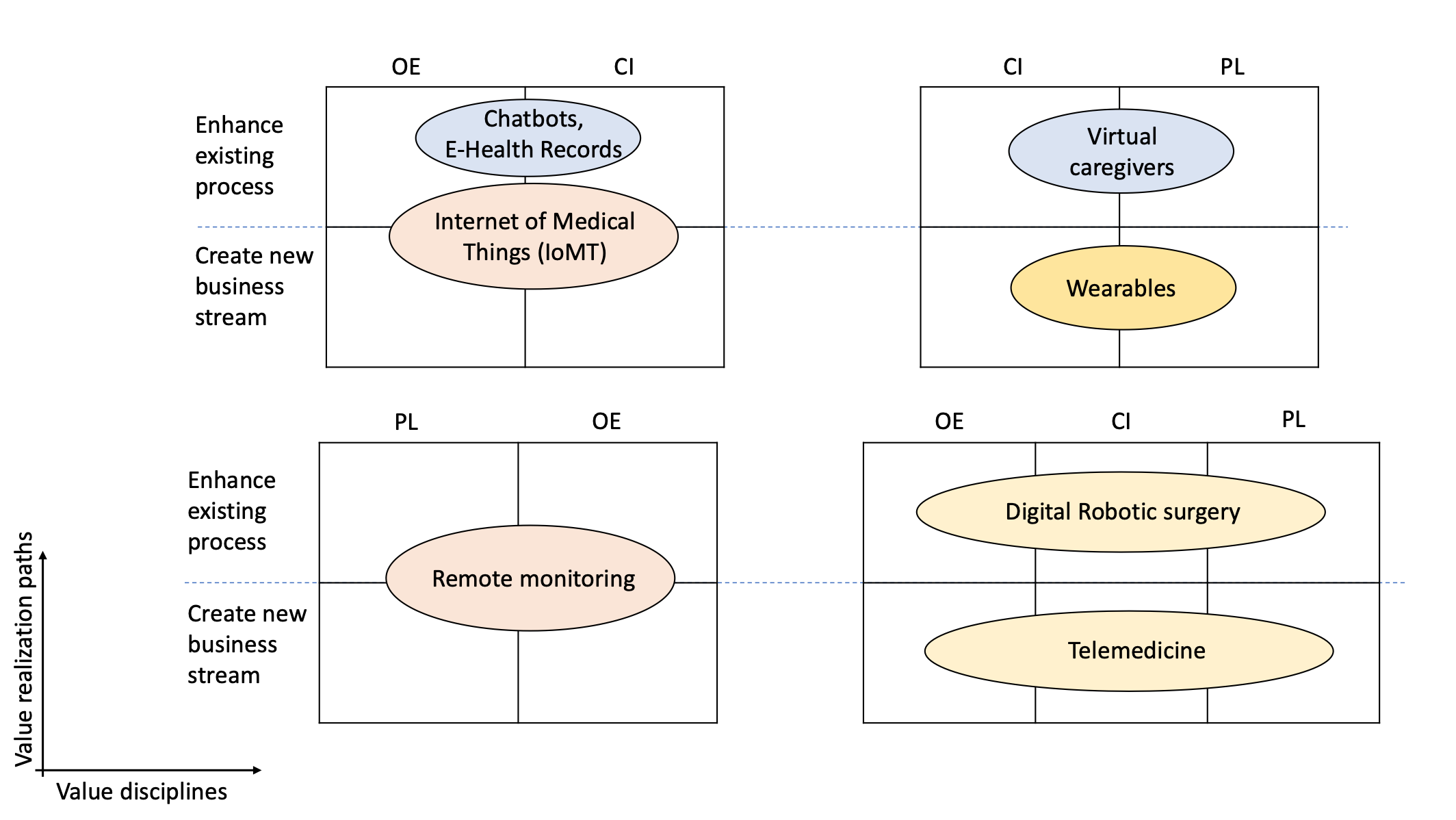California Management Review
California Management Review is a premier academic management journal published at UC Berkeley
by Vijaya Sunder M, Siddhartha Modukuri, and Rajendra Srivastava

Image Credit | National Cancer Institute
The post-pandemic world demands a breakthrough in healthcare delivery. In line with the sustainable development goal (SDG 3) that articulates ‘Good Health and Well-being for all,’ the World Health Organization has recognized digital health technologies as an essential driver to this effect. Consequently, healthcare providers have accelerated digitalization as a disruptor of paramount importance.1 But, do they reap a full harvest of business outcomes in their digital efforts and investments? This article proposes a strategic framework for value creation and appropriation as a managerial resource for healthcare providers embarking on digital journeys.
“Value Impedance and Dynamic Capabilities: The Case of MedTech Incumbent-Born Digital Healthcare Platforms” by Asta Pundziene, Tobias Gutmann, Marc Schlichtner, & David J. Teece. (Vol. 64/4) 2022.
“Digital Transformation and Organization Design: An Integrated Approach” by Tobias Kretschmer & Pooyan Khashabi. (Vol. 62/4) 2020.
Suppose we were to examine healthcare markets in the 1990s, we could not have disagreed with a popular HBR article,2 where Michael Treacy and Fred Wiersema argued that firms gain market leadership by mastering one of the value disciplines–operational excellence, customer intimacy, or product leadership. They proposed that each discipline creates an indispensable value proposition that gives firms a formidable competitive advantage.
For example, integrated delivery systems (Mayo Clinic, Virginia Mason, etc.) have focused mainly on lowering costs, determining their operational excellence discipline for value creation. Community-based providers (local doctors and hospitals) have been traditionally known for customer intimacy–by knowing every patient by name and personalized preferences; some doctors continue to make house calls. By contrast, academic medical centers (UAB health, UCLA, Emory Medical, etc.) attract beneficiaries by relying on the latest medical technologies and the newest machines to provide state-of-the-art services, representing their dominant interest in product leadership.
However, the rise of digital technologies and associated disruptions have changed the tenets of value propositions and altered market dynamics forever. Indeed, the digital health technologies market size in 2021 was USD 145.5 billion and is projected to be USD 430.5 billion by 2028, with a compounded annual growth rate of about 17%. The advent of digital health technologies (like telemedicine, mobile health applications, internet of medical things, chatbots, healthcare analytics, wearables, home services, etc.) offers healthcare providers new methods of creating value for patients. While this increased the expectations of healthcare beneficiaries significantly, it also provides an opportunity for healthcare firms to leverage multiple value disciplines concurrently for value creation, an opportunity that the digital era presents. This enables multifold value appropriation for healthcare firms via profit-making, growth, and improved resilience as business outcomes.
Several healthcare providers worldwide have already commenced their digital transformation journeys.3 However, many healthcare organizations that invest in digital interventions do not reap a full harvest due to the lack of an appropriate digital strategy.4 According to our research, a digital strategy framework could fill this gap and serve as a managerial resource in healthcare.5 Key constituents that characterize this framework include realizing concurrent value disciplines for value creation and the consequent appropriation for improved business outcomes and overall well-being.
In early 2020, Intermountain Healthcare, based in Salt Lake City, rolled out a chatbot “Scout” to navigate calls and concerns from people worried about the possibility of COVID-19 infection and pointed them to further corrective steps.6 More than 157,000 people used this service in the first 2.5 weeks, and acting like a triage, it has reduced the call center volume by 30%, thus helping both quicker resolution for customers and efficient call center management, alongside tailoring communications and increasing accessibility to meet patient’s immediate needs round the clock. Thus, Intermountain healthcare achieved superiority in operational excellence and customer intimacy using Chatbots.
Similarly, the connected devices that send, store, and retrieve medical data comprise the Internet of Medical Things (IoMT, in line with IoT), enabling doctors and health practitioners to make actionable and informed decisions. IoMT helped streamline clinical operations and workflow management, leading to operational excellence. Healthcare providers implementing IoMT also gained customer intimacy concurrently as the data from devices enables hospitals to keep track of patients and provide timely insights into taking appropriate measures. For instance, Gauteng hospitals in South Africa introduced an innovative electronic Bed Management System using sensors. The data from sensors helped them to seamlessly identify the availability of beds across a cluster of sites resulting in a 2-hour reduction in the wait time for a bed. Consequently, the system provided timely access to emergency department patients’ care.
Virtual caregivers appeal to millennials as they promote healthcare via social platforms giving rise to new and customized products and services. In addition, these platforms help patients overcome their anxiety and apprehensions about their health conditions by connecting and learning about the experiences of other patients. A virtual caregiver, PatientsLikeMe, became the world’s largest integrated community through product leadership, as in 2022, it grew to around 830,000 people with 2,900 conditions.7 The company gained customer intimacy by effectively digitalizing customers’ complaints. They empowered patients with their data and gave them a platform to connect with other patients with similar conditions, symptoms, treatments, life experiences, and outcomes.
Another digital technology that empowers customers with data is wearables. With market estimates suggesting that the global wearable technology market size (for collecting individual health data) will grow three times over the next ten years,8 several startups (like Proteus, Neurotech, Augmedix) and technology firms (like Apple, Google, Microsoft, Facebook) are eyeing for product leadership in concurrence with the inherent value of customer intimacy of wearable devices.
A surge in demand for remote monitoring (a primary subset application of IoMT) was observed during the COVID-19 pandemic, as indicated by Mayo Clinic at Rochester, which claimed that demand for remote monitoring increased 20 times during COVID-19. That increase has persisted nearly two years later.9 Cloudphysician, a Bengaluru-based startup that remotely monitors ICU, captured this trend of its client hospitals using data-driven analytics of patient reports and electronic medical records (EMR). The company claimed to significantly reduce the cost of maintaining an ICU unit and is contributing to increasing its client’s revenue by 25%.10 Remote monitoring startups like Cloudphysician are thus enabling the concurrent value disciplines of Product Leadership and Operational Excellence for their clients.
Consider USMD hospital at Arlington, which ran aggressive campaigns on its product leadership of minimally invasive robotic surgery that resulted in an increase of surgeries by 15%.11 As the robotic surgery had fewer complications and assisted patients in quicker recovery with lesser pain, USMD gained customer intimacy. Additionally, robotic surgery enhances precision, flexibility, and control of surgical procedures compared to traditional methods, improving the processes of surgical operations to achieve operational excellence. With the combined power of value disciplines, USMD led the segment in robotic surgeries.12
In the same vein, the largest hospital chain in India, Apollo Hospitals, launched a mobile application, “Apollo 24/7” that attracted over seven million registered users and a million weekly active users within a year of its launch. Apollo gained significant traction in volume by coupling the application with its network of 115 telemedicine centers. The new operating model accounted for more than a million daily teleconsultations and 40,000 medicine deliveries.13 The combined powers of value disciplines assisted Apollo in standing formidable against the competitors. Figure 1 summarizes the concurrence of value disciplines.

Figure 1: Dominant impact of technologies across value disciplines
The value created basis of the above-discussed value disciplines could be realized in two paths. First, digital technologies can enhance existing processes. For instance, digital robotic surgery enhances the traditional surgery method for speed and precision. Second, digital technologies could lead to new business models or develop new revenue streams. For example, telemedicine in the case of Apollo Hospitals – which started a new stream of businesses over its mobile technology.
In some cases, healthcare providers may realize value in both these paths. For instance, Cleveland Clinic, which existed at the forefront of innovation, embraced digital technologies in a short time during the COVID-19 pandemic and enhanced its processes by automating and optimizing patient-facing workflows. In parallel, they created scaled digital online/mobile platforms enabling patients to consult doctors online and access accurate medical information, leading to a new revenue generation stream.14 Together, these paths helped them to reach out to 75% of their patients compared to 2% on the original setup.
Mapping paths of value realization with concurrent value disciplines results in a managerial framework for application (see Figure 2). This view provides a managerial resource to choose appropriate digital health technologies based on the strategic vision reflected in the value realization path of a healthcare firm.

Figure 2: Mapping of Value realization paths over Value Disciplines
After identifying concurrent value disciplines and value realization paths, the next logical step is to convert the value created into business outcomes, a strategic process known as value appropriation.15 After all, the value created, if not translated into business outcomes, becomes meaningless in business contexts. There are three ways to value appropriation:
One, firms can appropriate value via profit-making. For instance, in March 2020, when Cleveland Clinic underwent a quickfire digital transformation in just two weeks, little did it know the significant improvement in its profitability. The hospital’s total unrestricted revenue was $12.4 billion in 2021, compared to $10.6 billion in 2020. Thus, the value appropriation of Cleveland Clinic’s digitalization is reflected in its increased profitability in the subsequent year.
Two, firms may invest in growth. Fortis Healthcare, India in 2013, comprehensively invested in a 450-bed Fortis Memorial Research Institute intended to create a complete spectrum of state-of-the-art digital technologies, the first of its kind in Asia. The hospital increased to 1000-bed by 2015. In 2022, the Managing Director remarked: “The sector has been growing at 22% since 2016. Thus, we plan to grow along by strengthening the digital ecosystem and fostering telemedicine for diagnosis by adding capacity in more than six select cities.”
Three, firms can appropriate value by building resilience. Being resilient improves competitiveness as it enables dynamism and agility in organizations. Resilience is an organization’s ability to anticipate, prepare for, and respond to environmental dynamism to survive and prosper. Building digital healthcare assets and capabilities by investing in stronger infrastructure allows healthcare firms to withstand environmental shocks. For instance, according to a Bloomberg report, more than three dozen hospitals in the USA entered bankruptcy notwithstanding the COVID-19 pressures, with losses over USD300 billion.16 However, a few hospitals like Brigham & Women’s Hospital, Massachusetts General Hospital, and Florida’s Tampa General Hospital that had invested in digital infrastructure (intelligent robots, AI-driven interpreters, etc.) responded to the pandemic with courage and ingenuity.17 Thus, by building resilience in healthcare infrastructure, organizations could appropriate value.
We propose a three-stage digital strategy framework for healthcare firms. Stage-1 constitutes value creation via concurrent value disciplines, Stage-2 presents value realization paths and Stage-3 with value appropriation for business outcomes. Figure 3 summarizes our proposed framework.

Figure 3: Value-Driven Digital Strategy Framework
In sum, we propose the following managerial takeaways:
Healthcare organizations should continuously strive to create value by leveraging multiple value disciplines to gain a sustainable market advantage. Mastering individual value disciplines are important but insufficient to achieve competitive advantage in the current digital era. A digital strategy should be conceived based on the synergies of value disciplines.
Healthcare organizations should realize value by choosing at least one of the two paths of value realization. The chosen path(s) should drive the digital strategy execution.
The value created should be appropriated for business outcomes to realize digital strategy focusing on profit or growth or building resilience.
While our digital strategy framework serves as a guide for healthcare administrators, its application should be based on parameters that include location, type, legal structure, age, size, service demand, and competition of the healthcare facilities. Consequently, healthcare firms gain market leadership while ensuring healthy lives and promoting well-being.
Pundziene, A., Gutmann, T., Schlichtner, M., & Teece, D. J. (2022). Value impedance and dynamic capabilities: The case of MedTech incumbent-born digital healthcare platforms. California Management Review, 64(4), 108-134.
Treacy, M., & Wiersema, F. (1993). Customer intimacy and other value disciplines. Harvard business review, 71(1), 84-93.
Kretschmer, T., & Khashabi, P. (2020). Digital transformation and organization design: An integrated approach. California Management Review, 62(4), 86-104.
Davenport, T. H., & Westerman, G. (2018). Why so many high-profile digital transformations fail. Harvard Business Review, 9, 15.
Sunder M, Vijaya & Modukuri, Siddhartha. (2022). Explicating the Intersections of Value Disciplines for the Digital Era. Journal of Creating Value. https://doi.org/10.1177/23949643221117901
Drees, J. (2021). The future of healthcare chatbots. Physician replacement or enhancement? Becker’s Hospital review. Retrieved from: https://www.beckershospitalreview.com/innovation/the-future-of-healthcare-chatbots-physician-replacement-or-enhancement.html
Business Wire. (2021). Leading Personalized Patient Health Network Patientslikeme Raise $26 Million To Support Next Phase Of Growth. Retrieved from: https://www.businesswire.com/news/home/20210209005441/en/Leading-Personalized-Patient-Health-Network-PatientsLikeMe-Raises-26-Million-to-Support-Next-Phase-of-Growth
Grand View Research. (2018-2019). Wearable technology market size analysis report 2028.
Horwitz, L. (2021). Mayo Clinic Outline Benefits Of Remote Healthcare. IOT World Today. Retrieved from: https://www.iotworldtoday.com/2021/08/19/mayo-clinic-outlines-the-benefits-of-remote-health-care/
Sunder M, Vijaya & Deo, Sarang. (2021). Technology Decision Making in a semi-urban ICU, An intensivit’s dilemma. Harvard Business Publishing. Retrieved from: https://store.hbr.org/product/technology-decision-making-in-a-semi-urban-icu-an-intensivist-s-dilemma/ISB247
Balcom Agency. (n.d). Retrieved from: https://www.balcomagency.com/work/usmd-hospital-arlington-integrated-campaign
USMD Website. (n.d). Retrieved from: Robotic Surgery in Arlington, TX USMD Hospital Arlington (usmdarlington.com)
Rashi. (2016). Lifeline: Apollo’s digital disruption to delivery of healthcare in India. Technology and Operations Management (hbs.edu). Retrieved from: https://digital.hbs.edu/platform-rctom/submission/life-line-apollos-digital-disruption-to-delivery-of-healthcare-in-india/#:~:text=Apollo%20Hospitals%20is%20one%20of,delivery%20of%20critical%20healthcare%20services
Mixson, E. (2021). Digital Transformation By Fire: The Cleveland Clinic Story. Intelligent Automation network. Retrieved from: https://www.intelligentautomation.network/transformation/articles/digital-transformation-by-fire
Srivastava, R. K., Fahey, L., & Christensen, H. K. (2001). The resource-based view and marketing: The role of market-based assets in gaining competitive advantage. Journal of management, 27(6), 777-802.
Wittbold, K. A., Carroll, C., Iansiti, M., Zhang, H. M., & Landman, A. B. (2020). How hospitals are using AI to battle Covid-19. Harvard Business Review, 3(04).